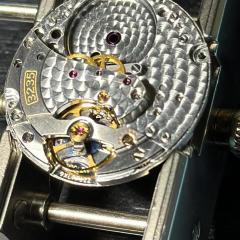Repair Michael Kors Mk3248 Watch
-
Similar Content
-
Recently Browsing
- No registered users viewing this page.
-
Topics
-
Posts
-
I remember the first few times I used my cheap crystal lift, the jaws did not open fully. But with the screw extended I could pull them open with fingers and afterwards it worked fine.
-
Depending upon how vintage it is there is no technical documentation to benefit from and very likely never was. Interesting comparison of ? So you're comparing a school and A association with classes to specific technical documentation specifically for specific watches or other documentation? I'm not quite sure how you would actually make that kind of a comparison On the other hand maybe it's because something is missing in your quote Oh other things that are missing from service manuals would be a lot of the early manuals when they were scanned PDFs were specifically scanned for parts only. So a lot of so-called service manuals have no servicing because it was not scanned. Evolution of technical service documentation is quite interesting. It also depends upon the particular company. Some companies the technical documentation is very poor because they assume you're skilled watchmaker you don't need technical documentation. Or maybe they only have aspects of some specific watch and nothing else. Then one of the problems we have in this discussion is if you've never seen what you're missing then you would not know and you might even perceived by not knowing that you're better off without it? For instance many years ago I purchased a watchmaker's estate. In there was omega technical documentation because he ran a jewelry store that sold Omega watches. So there's a few technical documents not overly impressive because Omega assumed your watchmaker and they don't have to give you a detailed about anything. typically the servicing would only cover interesting things and just general suggestions on lubrication. But what I was going to the documentation I found something interesting especially because involved lubrication which I find interesting. I've attached it is a PDF as you can see it covers oiling Omega and of course cleaning because you have to have a clean watch to oil it. I think this was my first exposure to supplemental information as I will call it not found in the general instructions. Oh and pay attention to the lubrication for the keyless I really don't understand why the Swiss goes so insanely lite for lubrication there. Evolution of documentation now cousins has working instructions the cover mostly generic general stuff there is a few specific calibers referred to in the working instruction but mainly it's just general stuff. Before cousins lost access they did obtain a few of the working instructions found at the link below. https://www.cousinsuk.com/document/search?SearchString=Working Here is an example of what happens if you're missing something? Omega also has general instructions for groupings of calibers work covers specific things related to that caliber. This information a course is not found in the general service documents if they even had general service documents a lot of times they do not they just have a parts list. So the specifically covering things that you really need to know and if you don't have this well? For instance there is an older discussion from 2018 but a couple weeks ago it came to life. Somebody was having a problem they fix the problem there very happy at least for now because the problem will come back as they haven't fixed the problem at all. If they had read the general instruction which they did not because they do not have access to it they would discover that putting the hands on his critical how you are supposed to do it because of you don't do it the way you're supposed to the end up with the exact problem you have here a damaged sweep pinion. Oiling Omega watches 1957.PDF
-
By rjenkinsgb · Posted
Sorry, no - these are the real model 987801; stainless steel with a white and blue (or black?) dial: https://www.chrono24.co.uk/cartier/ref-987901.htm -
Though I mostly do vintage I can’t say I’ve benefitted greatly from any company’s technical documents. Is anything in them infinitely superior to WOSTEP or AWCI? Maybe knowing details of purple winding gears and I guess epilame on all those other parts is fun…I still pull them and read when I can fine them I suppose 🧐…
-
One of the blessings of being an enthusiast is that I can spend whatever time I need on a watch to make it work as well as I can. Before I take on anyone's watch, I always tell them that I can't promise anything about how long it may take and what costs it might bring. Of course, any additional costs must be agreed upon. As you indicate, it's only when you're done that you know for a fact what time was required and the cost. It's the same pattern as with any complex undertaking, and repairing watches can be complex, even very complex. No, far from it. The secrecy from the big brands is honestly one of the most frustrating parts of this hobby. Even when you do manage to get hold of service manuals, they’re often missing crucial details—things like lubrication points or even just the safest way to disassemble and assemble certain components. Luckily, WRT exist, and over time you build up the knowledge and experience to work around the gaps. Sharing tips and hard-earned tricks here makes a huge difference. The secrecy itself seems to be part of the business model. Take the Rolex 3135 as an example—rather than clearly explaining how to safely remove the date ring in publicly available documentation, Rolex sells pricey training programs and certifications to their authorised service centres. And who ends up paying for that in the end? The customers, because independent watchmakers and passionate amateurs are pushed out. It’s a shame, really. If the car industry operated like this, the backlash would be huge.
-










Recommended Posts